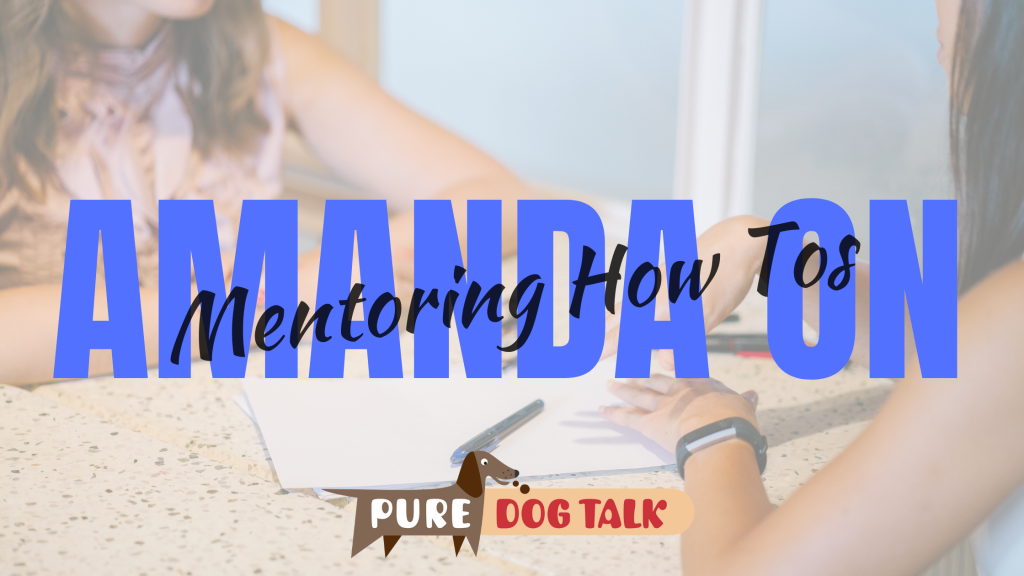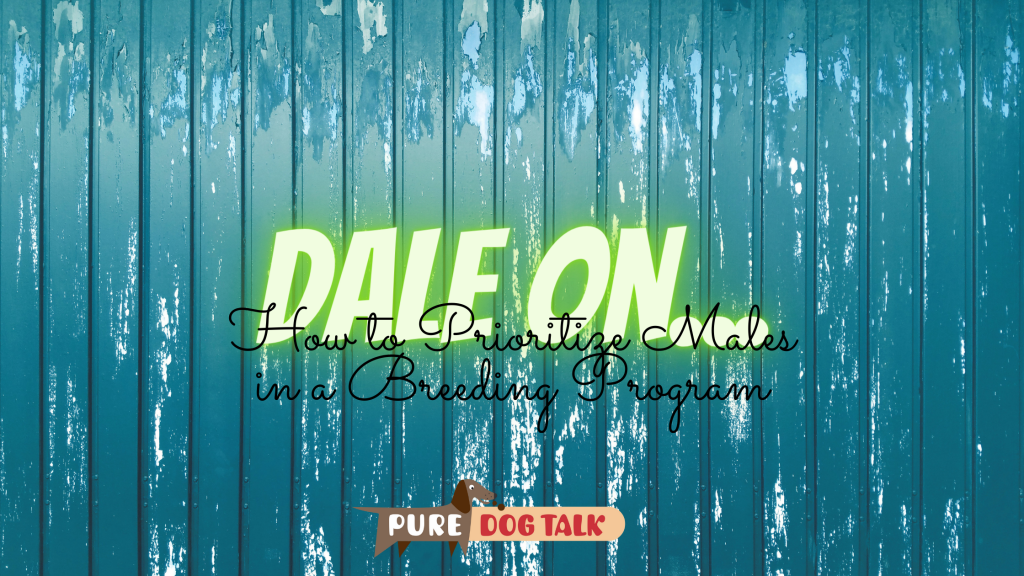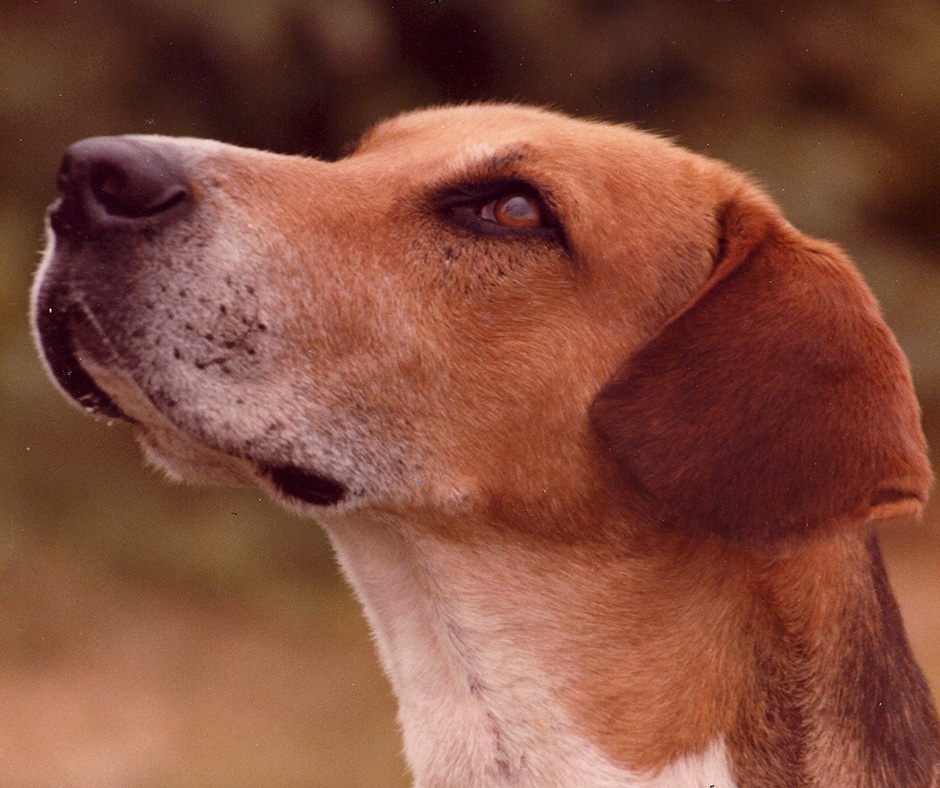446 – Mentoring How Tos: How to Give and How to Receive
445 – Stud Dog Shopping with Amanda Kelly
445 – Stud Dog Shopping with Amanda Kelly
Amanda Kelly, Fwaggle Toy Manchester Terriers, joins host Laura Reeves to talk about their favorite thing, shopping! Not for shoes but for stud dogs. Finding the right dog for your specific bitch, your breeding program as a whole and the breed in general, is a process that takes time and effort.
“When you’ve been breeding for a long time, you don’t really stop and think about what that process is,” Kelly said. “I think that there’s a couple of foundational pieces that go into choosing a stud dog. They may not seem like they’re directly related, but they really are so important.
“I think the first step is to look at your own bitch and your own breeding program and what you want to accomplish with a given breeding. One of the things that I keep coming back to is that you have to think about what your priorities are in a breeding. Before you start looking at any stud dogs or what anybody else has or what might be available or what might be possible, the very first thing to do is to really sit down and look at the bitch that you want to breed. What are her strengths? What are her weaknesses? What are the strengths and weaknesses of the family of dogs that she comes from.
“This whole process is really about research. You’re going to research a stud dog but you also are going to look really carefully at your family of dogs that you’re working with. You can learn so much about what will be or might be produced by looking at what has been produced. When we start out you kind of feel like you’re at a disadvantage because XYZ breeder has been breeding for 25 years and they know all of these dogs. That’s true. They have seen them over time, collected information, but some of that information really is available to everybody.
“Look at your bitch and think to yourself, ‘OK, were any of her littermates bred? What about dogs that are out of the same mother. Have they been bred? What about this bitch’s mother? Strong bitches are the cornerstone of any breeding program. What did the mother produce? What has the sire of my bitch produced?
“All of that information is going to fit together like pieces of a puzzle and give you a really clear idea of not only the strengths and weaknesses of your individual bitch but of perhaps the bloodline and what it’s producing.
“You can ask 25 breeders and you will get 25 different opinions of the relative merits of any approach to breeding and none of them are wrong. So the experience of your breed mentors, particularly folks who are working in the same group of dogs that you are within your breed, are really invaluable.
“There’s a longer term plan rather than 100% just the breeding that’s in front of you. I also like to think about what the priorities are for my breed. Coming from a small breed, there’s some elements I think of gene pool management. As a breeder in a small breed this is something that’s top of mind for me quite often in that there’s some gene pool management pieces that I think are important for me to consider as far as what’s the best for my breed’s diversity.”
444 – Stud Dog Contract Do’s and Don’ts
443 – A Summertime Garden Party with Westminster KC
442 – How to Prioritize the Males in a Breeding Program
How to Prioritize the Males in a Breeding Program
Dale Martenson, renowned breeder at Touche Japanese Chin, joins host Laura Reeves for a conversation about when, why and how to prioritize male dogs in a breeding program. Everyone knows to keep a bitch. But it can be much more challenging to keep good stud dogs to move a breeding program forward.
With a shoutout to Kenny Rogers, “You gotta Know when to hold ‘em and know when to fold ‘em”…
“Every gambler knows
That the secret to survivin’
Is knowin’ what to throw away
And knowin’ what to keep
‘Cause every hand’s a winner
And every hand’s a loser”
“Most breeders have two or three bitches,” Martenson said. “But (if they) keep a male puppy, he’s too closely related to the mother, the sister and the aunt that they already have … so really what needs to happen, is people need to get a circle of friends together where they can keep stud dogs in kind of a joint ownership that they can share … because very quickly after you’ve used your dog once or twice you may not need that dog … your other option is you can go ahead and collect that dog, freeze it and put it on ice … so you can reuse that later on when your pedigrees are open enough to take it, when you’ve gone down the road a couple generations.
“We really have to try to keep as much diversity as possible (in our breeds) and it helps having those dogs available. But the other thin,g when you go to just use a stud dog and you haven’t bred from it, you really don’t know what you’re gonna get from that dog until you’ve had a couple of outcross litters, and a couple of line bred litters and you’ve watched the puppies grow up out of them. You won’t know your long run health testing for four or five years,” Martenson said. It’s a long range proposition, he added.
“We take such comfort in what we don’t know. Not knowing is like the blind faith in the universe that we’re not gonna worry ‘bout this it’s all gonna be fine… You go and you import something from another country … you don’t really know much of anything behind it… they’re pretty radical outcross and you just don’t know.”
For more of Dale’s take on prepotent sires, “name brand” sires, NOT breeding to ribbons and so much more, be sure to download and listen today.
441 – Veterinary Voice: Infertility in the Stud Dog
Veterinary Voice: Infertility in the Stud Dog
November is all about boy dogs! Dr. Marty Greer joins host Laura Reeves for a conversation about the causes of infertility in the stud dog. From poor collection technique to managing enlarged prostate and more uncommon problems, Greer provides invaluable insight into the causes and potential treatments of sterility or low fertility in male dogs.
“We can start with defining the difference between fertility, infertility and sterility,” Greer said. “Infertility is low fertility. Sterility is a permanent condition. So if your dog is sterile, there’s no going back. The implication is that his fertility is low and in some cases, not all but in some cases, we can restore fertility with the combination of appropriate diagnostic work up, appropriate intervention for medications and nutritional supplements and diet.
“So those are kind of the four hallmarks of what we can do for your stud dog. Sterile would be, by my definition, on more than one occasion doing a collection of the stud dog and getting no sperm. Zero live or dead sperm on multiple collections. So there may be sperm that are there that are dead. There may be sperm there in low numbers. But if you see absolutely no sperm on more than one occasion, and you think you had a pretty good collection based on his libido, then I would probably classify him a sterile. But we can certainly talk about some of the diagnostic testing that should be done.
“The sperm are made in the testicle and then the epididymis is the conduit by which the sperm leave the testicle and make it up into the urethra and are ejaculated. So it’s this series of really cool, tightly little coiled tubules that run on the backside of the testicle and up around and then into the urethra where the ejaculate comes from. So the epididymis, if it’s blocked somewhere in that on both sides, then you’re not going to get sperm.
Hands off the junk, lady!
Some young or inexperienced stud dogs may not fully ejaculate because “their head’s not in the game,” Greer noted. She shared tips for getting a better collection from the male.
“Mostly it’s practice. A lot of those are dogs that have been in pet type home, not a breeders type home. You basically need some practice. You need a dog that has a really good female in heat standing in front of him. A really cooperative female. So not a bulldog that’s making weird snorting noises, even if she’s nice, ’cause sometimes that’s misconstrued as a growl. Not a dog that’s going to turn around and kind of nibble at the boy. But a girl that’s going to back into him and send an engraved invitation, ‘hey big boy it’s over here.’ So you want to have an experienced, really cooperative, in heat, at the appropriate time in heat, female. That’s not always easy to achieve, as you know, you don’t always get to pull one off the shelf when you need one.”
Prostate myths
“Many people are confused about what to do with prostate disease,” Greer observed. “There’s basically four different categories of disorders we can see in the prostate. We can see benign prostatic hypertrophy, prostatitis, prostatic cysts and there can be cancer of the prostate. So those are the four general diseases that we see. A lot of dogs when they’re age 5 and older, when they’re around a female in heat … will stimulate the dog to develop some enlargement of his prostate. After age 5 will see these dogs stand up from laying down or walk into the house and blood will be dripping from the penis. Every veterinarian that doesn’t do reproduction says ‘oh OK, there’s two things we have to do here. One we have to put him on an antibiotic and two we have to neuter him.’ Well actually, both of those things are incorrect.”
440 – Successfully Collecting, Shipping and Freezing “Swimmers”
Successfully Collecting, Shipping and Storing “Swimmers”
Shannon and Sydney Stone from ICSB NorCal join host Laura Reeves for a detailed and educational conversation about collecting, shipping and freezing a stud dog’s semen, aka “swimmers.”
Mother and daughter share their vast experience with different extender media, freezing methods and tips and tricks for a successful collection of the stud dog.
Test drive extenders
For fresh chilled collections, Shannon strongly advocates for collecting a potential stud dog and doing a “chill test.” This enables the practitioners to save the semen in a variety of available media in order to be sure which one works best with the specific dog. Dogs are individuals and not all semen will survive in every media. It is critical to know this *before* that super important, exciting breeding that has been planned for years.
“It just basically boils down to finding the best media for your dog,” Shannon said. “There’s so many good medias on the market right now, it’s just what’s the best fit for your dog and what works best for you as a stud owner.
“Some of the best collections we see are ones where either the owner has a centrifuge or they took the dog to the vet and the collection is centrifuged and we’re only getting that sperm rich fraction added to the media.
“Kind of a rule of thumb that we’ve seen is, no matter what media you’re using, you can expect that … the loss of integrity to be about 20% per day that you’re holding a sample. So say you get a sample in on Friday or Saturday but the bitch really isn’t gonna be ready to breed til like Monday or Tuesday. We can check the semen and if we need to add a little bit, as long as we know what media was sent in, you can sometimes add a little fresh media to perk it up.
“What we say to our clients that are going to be shipping basically … a sample is always better in the bitch than in the box.”
Pellets vs straws
Frozen semen is stored in one of two methods. As “straws,” the original method developed by cattle breeders, often called “cattle straws” and “pellets” the method developed originally by ICSB. Sydney recommends, again, a freeze test to be sure which method is best for the individual stud dog.
The primary importance, Shannon noted, is to work with a veterinarian who is accustomed to the type of freezing method chosen. Thawing pellets and straws is two completely different processes. Using the wrong thaw method for the type of frozen semen will kill it immediately.
Collection Tips and Tricks
Technique, a teaser bitch and a relaxed stud dog are the keys to success, the team agreed.
“You have to know your dog and kind of change things up to accommodate him,” Shannon said. “It’s not one size fits all.”
Listen to our previous stud dog series with Shannon and Sydney here, here, here and here.
439 — Throwbacks: Competition vs Collaboration; Safety and Grace
Throwbacks: Competition vs Collaboration, Safety and Grace
Laura throws back to 2017 As the Wheels Turn columns touching on big topics during the final day of Back to School month.
You Win. I Lose.
Many of us involved with purebred dogs find purpose, excitement and enjoyment in the heat of competition. The adrenaline rush is part of the passion we bring to the game. Whether it is realized in the whelping box, in the show ring or in competitive performance venues. It becomes ingrained deep in the grooves of our brains…. Winning is good. Losing is bad.
That’s fine as far as it goes.
But…
Sometimes the passion morphs and becomes something altogether different. The “If You Win, I Lose” mindset is the root of many evils in our fancy. It applies to everything from jealousy over another exhibitor’s win to the fiefdoms of kennel clubs. We encounter it in the *expectation* that any friendly overture has an ulterior motive.
As a whole and with exceptions in emergencies, we are not a cohesive group. Number one. First. Best. Foremost. Record-setting. These are our golden idols and, too often, we guard them viciously.
But that “dog in a manger” attitude serves only to divide and conquer our fancy.
How does it hurt you to help someone else? What harm to have two good dogs, ideas or events? What if we celebrate, support and cheer on others who are doing well or doing good?
Teach the newbie. Help the youngster. Support someone else who has a good dog, a good idea or an exciting plan. What’s the worst possible thing that could happen? That you wouldn’t be the best? The point of the exercise to challenge ourselves to continue to improve — our breed, our skills, our knowledge. The only way that will happen is if someone comes along with a better mousetrap, as they say, and we have to improve on our design.
Ours is a tiny microcosm of the real world. We would do well to remember that making it smaller with petty squabbling does nothing more than weaken our ability to resist outside forces working hard to squash us all like bugs. Anybody read the AVMA proposal about “regulating breeders”? I highly recommend Bill Shelton’s article in the June 6 “Dog News Magazine” for a bit of perspective.
Let’s make a conscious decision to see others’ success as the same as our own. Because then, the purebred dog fancy becomes a powerful force for good in the world. When you win, we ALL win takes us to an entirely different level of influence. Whether in legislative matters or in creating an appealing and exciting sport which draws participation and builds our future from within.
Winter wonderland
Traveling to winter shows can be a little dicey (heck, in some parts of the country questionable driving weather lasts until May!). Ya’ll down there in Florida, just be careful of the weather envy being directed your way.
I can remember driving to the St. Paul, Minn. shows when I lived in Nebraska. Driving on I-80 looking at *hundreds* of cars literally upside down on the side of the road before I decided it was time to pull over and stop somewhere. Or driving home from Chicago and all of the sudden the water on the antenna in the RV wasn’t dripping anymore and the road was freezing around me…
In the dog fancy, we sometimes have to make choices. Decisions that should be easy in terms of safety first are often questioned … But, I could win! But, I could starve! But, but, but….
In the Pacific Northwest we don’t normally get hammered with the type of weather other parts of the country deal with routinely. Snow, ice, and dangerous roads. Here, sadly, we are often poorly equipped to deal with it… snow plows, de-icer, sand and salt being foreign language in the land where it never (well almost) gets above 80 degrees (F) or below 30…
I personally missed out on Palm Springs a few years back due to weather. A good friend (another handler) chose to cancel out on the Puyallup shows rather than fight through sheets of ice on the roads between here and there.
As we speak, people are stranded, the freeway closed for ice storms. Flights get canceled and judges can’t get out. Inevitably, every 5 years or so, even the Garden has such a horrible blizzard people can’t get there … one reason some folks were thrilled to see Westminster Kennel Club moved to June this year.
So, I guess my point is this. When and what makes the call for you? Either professional or amateur. At what point is it not worth it?
When I announced to my social media (clients, friends, etc) that I wasn’t going to make it to that Palm Springs show, there were lots of supportive comments (at least publicly). Then I saw this note from a former boss, friend and mentor… I was quite startled at first, but it brought tears to my eyes as I read along.
“Oh for goodness sake Laura. I thought I taught you better than this. Toughen up girl.
You need to let the “Dog Show Addiction” take over your judgement. Screw with your safety let alone the dogs safety the(re) is a Dog Show to get to.
“Does it really matter if the end result is you end up in a ditch freezing? Maybe you just lose a dog or two. No matter someone will tow you out and you still may make the last day it’s the best judge for that last point anyway. As long as you don’t have a head on crash with a Semi that wipes you and the dogs out which God Forbid might break a major. At least they will say you tried to make it. …”
While the comment ended with praise for my decisions and generally glowing character, the initial shock to my system was I could actually **hear** other people saying *exactly* this… And meaning it.
In what world is a dog show worth risking our lives or our dogs’ lives? (PS I’m not even touching COVID, but it does have some bearing here….) The older I get, the more risk averse, I suppose.
It all goes hand in hand with when is it too hot in the summer to show dogs outdoors, and so on.
I guess, for me, the decision is about the dogs. Will they be safe? Is there a better than the average “every time I drive somewhere an idiot could crash into me” chance of disaster? We band together to watch each other’s backs, report road hazards, caravan, cover dogs, offer safe stopping places and otherwise be of assistance. But in the end, each of us has to make these decisions for ourselves and for the dogs in our care.
Let’s continue to support one another as we all do the very best we can do, with what we have to work with. To my friends, cohorts and companions, I bow to your strength and endurance and enduring humor in the face of what sometimes seems overwhelming adversity.
Seven virtues
Let’s all try to practice the grace we’d like to receive for our own failings…
“In the Catholic catechism, the seven virtues refers to the union of two sets of virtues. The four cardinal virtues, from ancient Greek philosophy, are prudence, justice, temperance (or restraint), and courage (or fortitude).
The three theological virtues, from the letters of St. Paul of Tarsus, are faith, hope, and charity (or love). These were adopted by the Church Fathers as the Seven Virtues.” — Wikkipedia
The beautiful part of this topic is it strikes to the core of why so many of us have stayed loyal to what can be a tough sport. I know there are folks out there who have never experienced some of these aspects of the fancy. It makes me sad. I can only offer the input of long-time fanciers. And suggest that, as in anything, we get what we give.
Courage
From reader Maryke Nau, Ridgefield, WA:
“One of the seven virtues that struck me for the dog show world based on many of the conversations I have been having with breeders was Courage, from a few different perspectives:
*Merely taking your beloved pet, the hours of time and money and raising, and asking somebody to give their objective opinion is courageous, especially when the “judge” rarely has to give any reasoning, you just have to suck it up and take the opinion.
*No other sport has amateurs competing against professionals. These owner-handlers who do this as a hobby and compete against someone that makes it their entire life is nothing short of courageous.
*Many breeds face challenges with clearances and health issues, but it is the courageous breeders that are public for the sake of learning and willing to address their issues, even it means starting over. When somebody says they don’t have any health issues, it merely means they haven’t been honest and courageous enough to look.”
Charity
From reader Linda Ercoli, Southern California:
This organization is perhaps the quintessential “heart” of our tribe. For every story of people helping people on a purely personal level, and they are legion,TTL multiplies the effort and takes it to a whole new level.
In the 20 years since its inception, TTL has paid out $3,879,017 to members of the fancy who were desperately in need.
From the TTL website:
“Take the Lead was founded in 1993 as a not-for-profit foundation under Section 501 (c)3 of the Internal Revenue Code dedicated to provide direct services, support and care for all qualified participants in the sport of dogs who suffer from the devastating realities of life-threatening or terminal illnesses.
The AIDS crisis opened our eyes to the many ruthless illnesses that were
challenging us to our very core. Though we came together week in and week out to compete at shows and trials, to participate in club activities, to share knowledge and common interests, we had inadequate resources in any one place to take care of those in our community who so clearly needed our help…….
In 1995, we established a permanent restricted fund and determined that up to one half of each year’s net income would be placed in it. Already we have seen this seed investment become a substantial asset. It is our goal that one day the interest earned on this endowment will provide more than enough income to cover the expenses of everyone in our sport who qualifies for assistance.”
Learn more at http://takethelead.org/
Prudence
A reader emailed me early on in the publication of this column with commentary on the topic of professional handlers being too chummy with judges. One of the statements in this missive completely floored me. “We don’t know any judges.”
My first thought was, why not? They aren’t aliens! Volunteer for your all-breed club. Ring steward. Help with hospitality. Join a committee within your national or local breed club. Get involved in something larger than just yourself. When you have that background, inevitably you will wind up being judged by someone you know personally. Use common sense and be polite but reserved in your public interactions. Everyone has lines they won’t cross. My rule is, I will not show dogs to my close friends or former clients. It invites bad juju. On the other hand, I know lots of members of this tribe — from casual acquaintances, to breeders with whom I regularly interact on club business or have known for years, to former colleagues and competitors who have “aged out” of handling and are now judging. I have to respect that these folks will judge the dog on the day or I would be left with a very limited pool of people to whom I could show dogs.
Hope (and Faith)
Perhaps there is nothing more hopeful in the world than a new puppy. Years are spent planning a breeding. In the best of all worlds, you are creating dogs specifically designed to make the next breeding. Without fail, there is a flutter in your chest, a glimmer in your eye, a catch in your breath when they start opening their eyes and forming their own little personalities. Every step of the way, from the second the sack is broken at birth, through evaluation and placement, weeding out, testing, watching and waiting for the ONE, there is hope. I know a few denizens of the sport who bought the ONE, some even by accident. But as a breeder (long before I was a handler), the hope, faith and joy involved in a litter of new puppies is unparalleled. Hope, often as not crashed on the rocks of some fault, small or large. Faith that the next “twist” will do the trick. Joy when all those plans and blueprints (ie pedigrees); all the blood, sweat and tears of pain and happiness; all the anguish and anticipation, finally gel and you get, almost, the ONE. Then, you try, again, to perfect it.
Justice (and Temperance)
Never let it be said there is no justice in this sport. I see it every weekend. The underdog wins far more often than the popular myth would have you believe. They just don’t talk about it as much. I love to watch talented breeder-owner-handlers. People who have studied and perfected the art of their breed. People who have bred, trained, conditioned and groomed their dogs to the nth degree. They routinely beat me. I find those people and learn from them!
These are competitors who practice temperance. They do not follow fads and trends. They doggedly (bad pun) breed to the standard, whether it fits with the current fashion or not. These people avoid excess in their breeding programs, in their advertising and in their behavior.
It matters not whether the breed is Basenji or Pug or Clumber Spaniel or Akita. Patience is part of this virtue. Breeders, owners and handlers who are building on a solid foundation for the future they envision, even if it is different than the one I would choose, will always be my heroes.
438 – Richard Reynolds – Rat Hunter of Manhattan
Richard Reynolds – Rat Hunter of Manhattan
Richard Reynolds joins me for part two of our conversation. This time we’re talking rat hunting with Terriers in New York City.
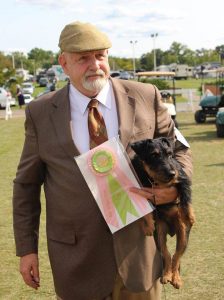
Richard Reynolds with a Jagd Terrier, shown in FSS at Open Shows.
“Quite fairly there was never a transition (from hounds to terriers),” Reynolds said. “I was always interested in hunting the terriers. We don’t have as many Fox in the United States as they do in England … and you had to work a little harder. Bringing up the terriers and putting the terriers to ground was always a part of our Fox hunt.
“When I left the pack, I wanted a purebred terrier that I could show. Somebody slipped me into a low mileage used Norfolk terrier and that suited me pretty good. But I didn’t know whether it could hunt or not. A few years later and a little experience and a few Norfolks later, we proved they were damn good hunters. In fact, the best terrier that I’ve ever had to this day remains one particular Norfolk.”
Reynolds’ rise to fame as the Rat Hunter of Manhattan started at a dog show in Liberty Park at the base of the Statue of Liberty. Rats had overrun one of the handlers’ setups and he turned his Norfolk loose to do its job. The park superintendent happened to see this feat. The rest, as they say, is history.
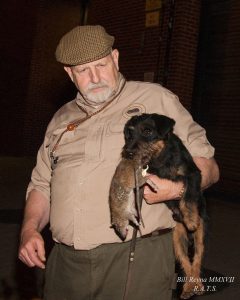
Jagd Terrier with Reynolds and one less rat on the streets of Manhattan.
“If I tell you that my dog is a good rat catcher, you won’t care,” Reynolds opined. “If a rat is headed to run up your pant leg and my dog stops it, you’ll have a lot of respect for that fuzzy little critter down there. So that’s exactly the way we’re trying to make our point.
“We’re all about an idea. That idea is preserving breed type through maintaining the actual function of the dog. You can simulate all these things but you can’t replicate the actual deed of hunting or ratting or whatever. It’s different. It’s about the dogs but don’t tell anybody because we get an awful lot of good press on the fact that we’re killing rats.
“We can’t show purebred dogs to the media. They don’t care. Dead rats are a big seller. We have media with us (nearly) every night that we go out. We’ve had a lot of media. But that’s our little way of selling purebred dogs to the public.
“We’re doing it for the sake of the dogs. There’s no money here. All sport is ruined as soon as you monetize it. So we don’t charge to hunt. Our members occasionally cough up $5 each time they hunt, but more often than not they forget to pay it and we forget to collect it. So it’s kind of a thing for the dogs, by the dogs and of the dogs. A good night is when the dogs work well together. A bad night is when we don’t get anything.”
Reynolds has been instrumental in setting up a training ground in southern New Jersey. The primary purpose of which is running AKC earthdog tests.
“We use it as a basic training ground for terriers and dachshunds,” Reynolds noted. “It’s not the same thing (as street hunting). Once they get through the earth dog program there’s a lot of on the job training but it’s a starting point. The sport of AKC earthdog or den trials or Jack Russell terrier Association go to ground is kind of diminished in recent years. We use it for training Street dogs but really what we’re trying to do is rejuvenate this sport in and of itself of earth dogs and den trials.”
437 – Richard Reynolds on Foxhounds and Favors
Richard Reynolds on Foxhounds and Favors
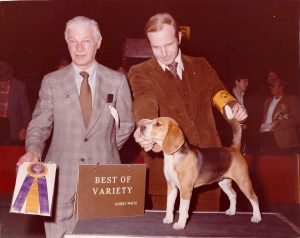
“Westminster 1977. BoV under Peter Knoop was 13” Ch. Englandale’s Crestwood Star. I sold her as a pet, but her owner believed that she could do anything and pushed me to show her. She not only finished her title, and won the variety at “the World Series of Dogdom”, she also had several obedience titles.”
Richard Reynolds is joining us today. This is the first part of a two-part episode. We’re going to talk about rat hunting and foxhounds and all kinds of fabulous historical stuff, because he is a brain trust of all things history in purebred dogs.
Reynolds said his involvement in purebred dogs “started from a National Geographic magazine. I was a young lad in his early teens and I came upon a National Geographic magazine that had an article Westminster, the World Series of Dogs” circa 1949.
“All of my colleagues had Playboy magazine hidden under their mattresses and I had National Geographic,” Reynolds said, “not for the same purpose of course.”
Reynolds said he acquired his first Beagle “for the princely sum of $35 from a gentleman who hunted them and, as they say, the rest was history.

“The hound was Mr. Stewart’s Cheshire Federal, a gift to me from Nancy Penn Smith Hannum, MFH. There weren’t any other AKC English Foxhounds around, so we finished him the hard way…by winning groups. I believe he was the second AKC Ch. English Foxhound.”
“The first Beagle fell somewhat short of being a show dog, but the next one was a show dog. It cost a great deal more than $35, although I’m not sure it was worth much more. That kind of got me started with the dog showing thing.”
Reynolds’ focus has always been on preserving breed type through concentration on performance ability. He was a Master of Foxhounds with the only dual registry recognized hunting pack. His Old English hounds won a group at Westminster, many Bests in Show, many Large Pack classes at hound shows and the occasional Grand Championship.
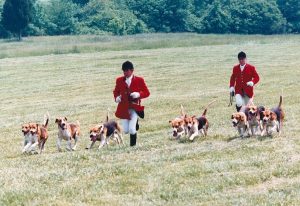
“These were my hounds in the Five Couple class at the Virginia Hound Show some years ago,” Renolds noted on social media.
Most important, Reynolds noted, each hound hunted a regular three day a week schedule.
Comparing the English and American Foxhounds, Reynolds notes, “The old English Foxhound is heavier, larger. Level top line. Picture, if you will, a bulldozer on feet. The American foxhound is lighter, leggier, has a slight rise over the loin to give it speed. It’s of course descended from the English Foxhound, but it’s not exactly the same.
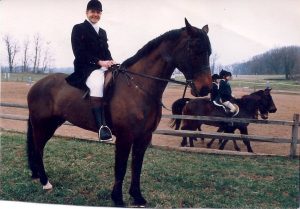
“When one is a visitor, hunting with another recognized pack, it is courteous to wear a black coat rather than scarlet with your home hunt colors. This was on such an occasion with my ex-three day eventer, Eastwick.”
“They both have their purposes and, like all of the hounds and terriers, that purpose is directly related to the country, the land where the dog hunts and works. American foxhounds are suited to the wide open spaces in the United States and the English are suited to the Gorse hedges and stone walls and whatever of England. We found them very useful in Pennsylvania where I’m at because we have a wonderful agricultural phenomenon known as the multiflora rose.”
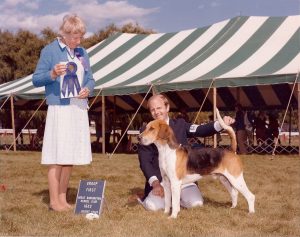
Ch. Mr. Stewart’s Cheshire Winslow. In 1983 Winslow was number one amongst all hound breeds and in 1984 won the hound group at Westminster.
Reynolds’ most famous dog was Ch. Mr Stewart’s Cheshire Winslow.
“He hunted pretty good and he was a reasonably good stud dog,” Reynolds quipped, “but he was a really good show dog. He was the top of all hound breeds in 1983, won the Quaker oats award for the top winning hound, and then he kind of walked out of Westminster in 1984 with the hound group. So having done that, we figured that we were duty bound to get him back to the hunt field the following morning. So he won the group at Westminster on Tuesday night, and hunted Fox from horseback on Wednesday morning.”
Reynold’s wry, self-deprecating humor is a treasure to the dog community. Enjoy this episode and join us next week for our conversation on terriers.

